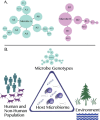Advances in Molecular Epidemiology of Infectious Diseases: Definitions, Approaches, and Scope of the Field
- PMID: 30387413
- PMCID: PMC6343655
- DOI: 10.1128/microbiolspec.AME-0001-2018
Advances in Molecular Epidemiology of Infectious Diseases: Definitions, Approaches, and Scope of the Field
Abstract
Molecular epidemiology is a discipline that uses molecular microbiology tools to study the distribution and determinants of diseases in human populations and veterinary animals. Our understanding of epidemiology of infectious diseases has evolved with technological advancements made in molecular biology that refine our perception of the identity and dynamics of microorganisms. This review is an introduction to the Microbiology Spectrum Curated Collection: Advances in Molecular Epidemiology of Infectious Diseases that will discuss how these advancements have contributed to investigations of infectious disease outbreaks/epidemics, surveillance, transmission dynamics, risk factor identification, pathogenesis, and etiologic attribution of bacterial, viral, protozoan, and helminthic pathogens to a disease. Here we define "molecular epidemiology" and distinguish it from other disciplines that use many of the same molecular biology tools-taxonomy, phylogenetics, and molecular evolution of microorganisms. The Curated Collection will be spread throughout multiple issues of Microbiology Spectrum and will be divided into four general sections: (i) laboratory methods used to strain type microbial pathogens, (ii) methods used to analyze genotyping data, (iii) examples of molecular epidemiologic investigations of bacterial, viral, and parasitic diseases, and (iv) applications of molecular epidemiology to address new research questions in communicable and noncommunicable diseases. The major theme of this Curated Collection is to address the following question frequently asked by clinicians, clinical microbiologists, and public health professionals: what is the advantage or unique contribution of molecular epidemiology in solving infectious disease problems in the clinical and public health arenas? *This article is part of a curated collection.
Figures

References
-
- Huang ES, Alford CA, Reynolds DW, Stagno S, Pass RF. 1980. Molecular epidemiology of cytomegalovirus infections in women and their infants. N Engl J Med 303:958–962. http://dx.doi.org/10.1056/NEJM198010233031702. [PubMed] - PubMed
-
- Riley LW. 2004. Molecular Epidemiology of Infectious Diseases: Principles and Practices. ASM Press, Washington, DC. 10.1128/9781555817688. - DOI
-
- Brock TD. 1988. Robert Koch. A Life in Medicine and Bacteriology. Science Tech Publishers, Madison, WI. - PubMed
-
- Mausner JS, Bahn AK. 1974. Epidemiology. An Introductory Text. WB Saunders Co, Philadelphia, PA. [PubMed]
Publication types
MeSH terms
Grants and funding
LinkOut - more resources
Full Text Sources
Medical

